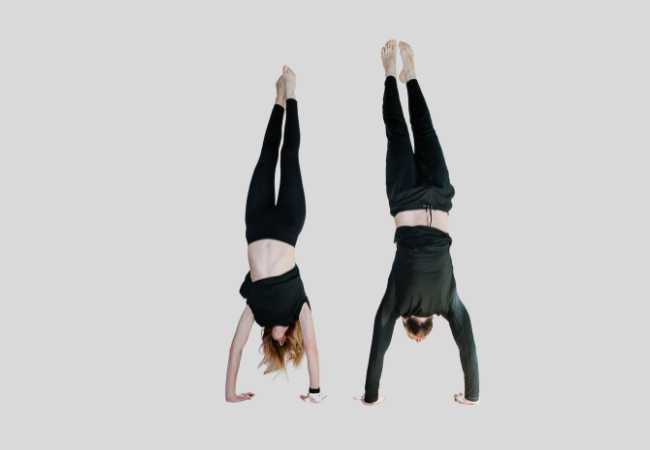Table of Contents
Setting the stage for the chest to wall vs back to wall handstand debate
Handstands are an impressive skill that requires balance, strength, and flexibility. As you progress in your handstand practice, you’ll encounter two common variations – the chest to wall vs back to wall handstand.
Both offer unique benefits and challenges. In this in-depth article, we’ll analyze the pros and cons of each type of handstand to help you determine which is best aligned with your current skill level and training goals.
Understanding the nuances of the chest to wall versus back to wall technique will allow you to advance your handstand practice safely and efficiently.
Understanding Handstands
A handstand involves balancing the body upside down in an inverted vertical position, supported by the hands and arms, while the legs extend straight toward the ceiling. The shoulders, wrists, core, and legs must all work together to maintain stability and alignment in the inverted posture. Handstands require full-body tension, coordination, balance, and superior shoulder and wrist mobility.
The Basics Of Handstand Positions
The hands are shoulder-width apart on the floor in a standard handstand, while the fingers point forward and spread wide. The arms are straight and active, supporting the inverted body weight.
The shoulders are engaged by drawing the shoulder blades down the back. The core must remain hollow and pulled inward to prevent overarching in the lower back. The legs are held together, straight and active during a handstand to improve balance and stability. The gaze can be directed between the hands for greater focus and control.
The importance of balance and stability
Maintaining balance and stability in a handstand position is crucial. The slightest fluctuation in alignment, tension, or focus can cause the handstand to falter. Building proper shoulder and core strength helps improve stability as you work to control your inverted center of gravity over the base of support formed by your hands and arms.
Benefits of Practising Handstands
Handstands offer numerous physical and mental benefits:
Physical benefits
– Improved posture and spinal alignment
– Increased shoulder mobility and strength
– Enhanced proprioception and body awareness
– Core strengthening
– Promotes focus and concentration
Mental benefits
– Enhanced focus and concentration
– Boosted confidence
Regular handstand training can lead to noticeable strength gains throughout the shoulders, arms, core, and back. The inverted nature of handstands also counters the effects of daily gravitational compression on the spine, leading to improved posture. Handstands enhance proprioceptive awareness, allowing you to understand better how your body moves through space.
The concentration required builds mental focus. With consistent practice, handstands become an impressive skill that boosts confidence.
Related: 9 Effective Tips For Yoga Handstand
Chest To Wall Vs Back To Wall Handstand
What is Chest to Wall Handstand?
In a chest to wall handstand, the hands are placed close to a wall while the chest faces the wall directly. It allows the wall to be utilized for balance assistance and safety. Beginners can lightly touch their chest to the wall for stability as they work on proper handstand alignment.
Pros of Chest to Wall Handstands
– Allows beginners to get used to inverted posture safely
– Can kick up with control using a wall for balance
– Wall provides peace of mind for those learning
The chest to wall handstand is ideal for handstand newcomers. The wall’s proximity provides stability for beginners to experience the inverted handstand position with minimal fear. The wall assists with balance as students work on engaging the proper muscles and maintaining alignment.
The wall offers security, allowing students to kick into the handstand while controlling the motion. It builds confidence in the early stages.
Cons of Chest to Wall Handstands
– Limited shoulder opening compared to back to wall
– Harder to engage the core without wall support
– Can develop a dependence on the wall for balance
While useful for beginners, chest to wall handstands have some limitations. With the chest pressed near the wall, there is less emphasis on shoulder mobility. The wall can be used as a crutch, leading to underdevelopment of the core since the wall provides artificial stability. Over-relying on the wall prevents learning to balance without wall assistance.
Learning Chest to Wall Handstands
– Start close to a wall with hands 6 inches away
– Walk feet towards a wall, engage core and glutes
– Keep your chest close to the wall as you kick up
– Push shoulders down and straighten body
To properly perform chest to wall handstands:
- Set hands about 6 inches from the wall.
- Walk feet toward the wall to shift weight over shoulders.
- Engage core and glutes for stability.
- Maintain a slight hollow body shape.
- Kick up towards the wall, using it to assist the inverted balance.
- Keep your chest close to the wall.
- Press shoulders away from ears and straighten the body in one long line.
What is a Back to Wall Handstand?
In a back to wall handstand, the hands are placed several inches from the wall while the back faces the wall. There is less direct reliance on the wall for balance, engaging more core control.
Pros of Back to Wall Handstands
– Allows greater shoulder mobility and strength
– Engages core more without wall support
– Develops balance ability off the wall
– Can push through shoulders and open chest
Back to wall technique emphasises proper shoulder and body alignment. Greater shoulder mobility is required without the wall supporting the front of the body. Core engagement increases to balance without direct wall support. It improves true balancing skills off the wall. Pushing actively through the shoulders enhances posture.
Cons of Back to Wall Handstands
– Less wall support can feel less stable
– Falling backwards requires control to avoid hitting the wall
Back to wall, the handstand can feel less secure for beginners without the wall’s stability. Falling backwards could cause you to hit your head on the wall if loss of balance is uncontrolled. This risk requires building good core strength first.
Learning Back to Wall Handstands
– Start with hands 6 inches from wall, walk feet in
– Engage core, tuck chin, straighten legs towards ceiling
– Control kick up, use core to balance off the wall
– Push shoulders down, keep legs aligned over body
To perform back to wall handstand:
- Place hands 6 inches from the wall.
- Walk feet toward hands, core engaged.
- Initiate kick up, tucking chin slightly.
- Use core strength to balance the body rather than wall support.
- Maintain straight, rigid body alignment, shoulders active and down, gaze forward.
- Control the inverted position without an overarching low back.
Related: What Muscles Do Handstands Work
Which is Best for You?
– Consider your handstand experience and goals
– Try both to see which you prefer
– Use wall support as needed to advance your practice
There is no definitive “best” handstand variation. Choose based on your current skill level and goals. Beginners will benefit most from chest to wall technique for safety. Intermediate students can start training back to wall style in preparation for balancing without wall support. Even advanced practitioners can utilise the wall judiciously for balance assistance when needed. Experiment to see which handstand style you prefer.
Best Handstand Progression
– Master chest to wall before moving back to wall
– Build shoulder strength and body alignment
– Develop balance off the wall over time
For most students, mastering chest to wall technique first allows you to gain confidence in the inverted handstand posture. After building adequate shoulder mobility and body awareness, progressively reduce reliance on the wall to improve true balance skills. Ultimately, back to wall drills prepare you for balance without wall support entirely. Be patient as you develop proper alignment over months of consistent practice.
Handstand Drills and Training Tips
– Engage fingers, straight arms and active shoulders
– Tuck chin, reach the crown of the head forward
– Draw ribs in, engage the core and straight legs
– Controlled breathing throughout
– Kick up to inverted, hold, and lower with control
Proper handstand form requires active straight arms, engaged fingers, and energetic shoulder depression to stabilise joints under load. Maintain slight cervical flexion by reaching the crown of the head forward.
Hollow the core by drawing lower ribs inward. Extend straight, active legs together above hips for balance. Use controlled breathing during the inverted hold. Kick up smoothly into the handstand, hold briefly, then lower back down with control.
Tips for advancing in chest to wall handstands
– Gradually reduce wall support
– Focus on shoulder mobility and alignment
– Build inverted balance confidence
Tips for advancing in back to wall handstands
– Strengthen core and shoulder muscles
– Practice controlled kick-ups and negative descents
– Use wall assistance only when needed
Incorporating variations and drills
– Placing a foam block between the chest and wall
– Using lifting straps for support during chest to wall kicks
– Attempting stomach-to-wall handstands
– Wall handstand scapular pushes
– Wall-supported handstand leg lifts
– Wall handstand negative eccentric descents
Safety Precautions
Avoiding injuries in the chest to wall handstands
– Warm up shoulders and wrists thoroughly
– Do not hyperextend low back against a wall
– Avoid overtraining and fatigue
Avoiding injuries in back to wall handstands
– Build adequate core strength first
– Control descent to avoid hitting a wall
– Tap the wall with your feet if you lose balance
Knowing when to stop and rest
– At first sign of shoulder pain or wrist discomfort
– If core fatigues or back hyperextends against a wall
– When concentration and focus decrease
Handstands require full body tension and strength. Warm up the wrists and shoulders thoroughly before practice. Be cautious of low back hyperextension against the wall over time.
Back to wall technique risks hitting the head on the wall if balance control is lost, indicating the need for adequate core strength. Know your limits and stop to rest at the first sign of pain, fatigue or decreased focus.
Choosing the Right Handstand Variation
Assessing your skill level
Evaluate your current mobility, strength, balance and control. As a beginner, start with chest to wall handstands against a wall to build confidence. Intermediate students can begin working on the wall technique. Advanced students can practice balancing off the wall entirely.
Considering your goals
If you wish to learn proper alignment, chest to wall is safest. If building strength is the priority, back to wall challenges the shoulders and core more. To maximize balance ability, reduce wall support over time.
The role of fear and comfort
Fear of falling can influence the choice of handstand variation. Use wall support in the beginning to ease fears. As you build skill, shift away from the wall to challenge balance and bravery.
Common Mistakes in Chest to Wall Handstands
Overarching the lower back
Excessive lower back arching against the wall places undue strain and pressure on the lumbar spine. Maintain a neutral pelvis and hollow core.
Neglecting shoulder and wrist mobility
Lack of flexibility through the shoulders and wrists can inhibit proper handstand mechanics. Ensure adequate range of motion through routine stretching.
Lack of consistent practice
Sporadic practice prevents progressive improvement. Dedicate regular sessions to refine form and advance to new skills.
Common Mistakes in Back to Wall Handstands
Overreliance on the wall
Touching the wall for support too frequently hinders the development of independent balance skills.
Poor body alignment
Insufficient shoulder depression, hip extension and core hollow body activation decrease balance control.
Limited progression
Stalling at the same skill level requires more difficult drills to ensure advancement.
Progression and Skill Building
Steadily reduce wall support with chest to wall handstands. Move closer to the wall in back to wall handstands. Lift one leg or open the chest while inverted. Work with negative eccentrics. Add supplementary balance exercises. Handstands require patience and consistent skill refinement. Celebrate small wins!
A Word From Blogzah
The incremental successes of a disciplined handstand practice lead to immense satisfaction and confidence.
Both chest to wall and back to wall handstands offer benefits depending on your experience level, goals, and comfort with balancing inverted. Mastering proper form and alignment in the foundational chest to wall variation can build confidence for beginners. Back to wall technique challenges balance skills more without direct wall support in front. Listen to your body, progress intelligently, utilise wall assistance as needed, and enjoy the journey of honing an impressive handstand practice.
















